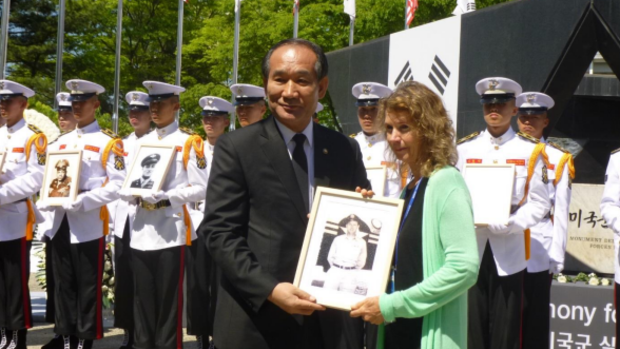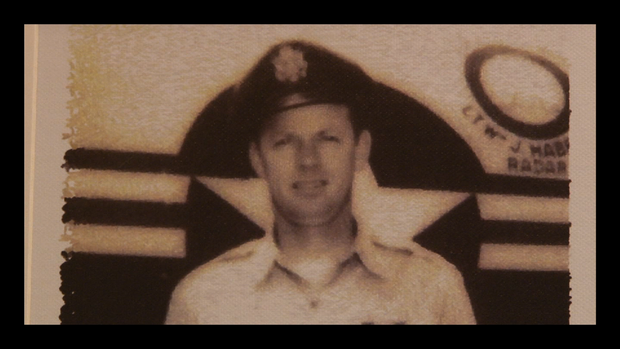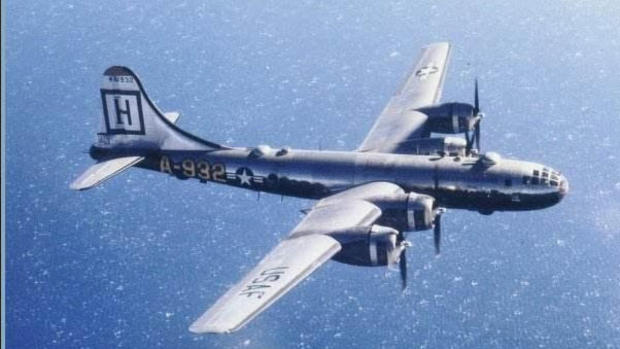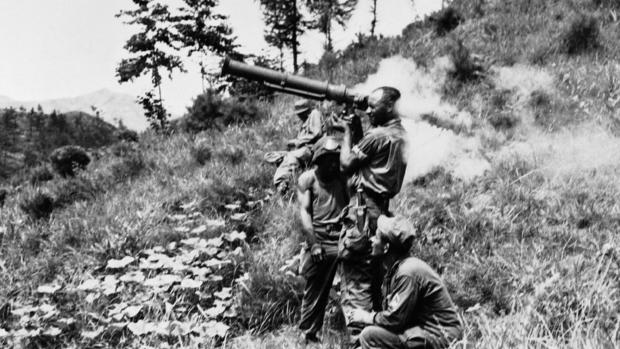Remembering the forgotten battle of the "Forgotten War"
No one would have blamed Air Force 1st Lt. William Haberle for feeling some trepidation on the morning of October 24, 1951 as he and the 10 other men on his crew boarded their Boeing B-29 Superfortress.
Their mission: bomb a railroad bridge that had become a supply line for the North Koreans. Their concern: what they might encounter at 20,000 feet.
Only the day before, another squadron of B-29s had become prey in the skies over North Korea. Their stalkers were Soviet Mikoyan-Gurevich MiG-15 fighter jets.
MiGs were fast, sleek and agile. They outmatched the B-29s, which were designed less for agility than the ability to carry 40 of the 500-pound bombs at a time, in aerial assaults.
But Haberle's mission went smoothly: the target had been destroyed and his crew was headed back to their base in Japan -- one bombing run closer to going home.
In those moments of triumph, the radar operator of another bomber in the formation snapped a picture of Haberle's B-29 -- "USAF" proudly tattooed across one side of the bombers' 155-foot long wingspan, the Air Force roundel with a white star in a Navy circle on the other. In between, four 2,200-horsepower engines propelled the B-29s occupants through a cloudless autumn day.
"It's weird to look at it," Mary Anne Haberle, the Air Force lieutenant's daughter, told CBS News, "because my father was on that plane and in those moments he was still alive and everything was going well and they had succeeded in their mission."
Her father never made it back to base. Twenty minutes after the photo was taken, more than 40 MiGs attacked. Fire broke out between the B-29s third and fourth engines. The men aboard were ordered to bail out at 14,000 feet over Wonsan Bay, on the western shore of the Sea of Japan.
First Lt. Haberle was never found.
The picture of his plane was, but only recently by his daughter. Haberle discovered the photo when she began doing research in preparation for a trip to South Korea.
In May, the South Korean Ministry of Patriots and Veterans Affairs hosted two-dozen siblings, spouses and children of U.S. service members still missing from the Korea War. For Haberle and most of the other families, it was their first visit to the country where their loved one disappeared more than 60 years ago.
"It's hard to put closure when you don't know," Sheila Badzioch said.
Little is known of what happened to Badzioch's father, Air Force Staff Sgt. Stephen Dougherty, after he was seen bailing out of a critically damaged B-29 over the Yellow Sea on October 23, 1951 -- one day before 1st Lt. Haberle's flight -- a day that's come to be known as "Black Tuesday."
Before sunrise that Tuesday morning, nine B-29s of the 307th Bombardment Wing, including a bomber carrying Dougherty, lifted off from Kadena Air Force base in Okinawa. They had been tasked with bombing Namsi Air Base, a North Korean airfield being built near the Chinese border in an area known to American pilots as "MiG Alley."
What ensued some consider to be the greatest jet engagement in the history of aerial warfare, the epic air combat of the Korean War that has become a largely forgotten battle in what's been called the "Forgotten War."
As the nine Air Force B-29s approached Namsi, nearly 200 enemy MiGs swooped in from above, slicing through the bomber formation with punishing bursts of cannon fire.
When the catastrophic attack was over, only one of the B-29s remained unscathed. Five had been damaged beyond repair. Three were destroyed.
Badzioch's father was onboard one of the downed B-29s. The loved ones of James Foulks, Diana Healey and Therese Iknoian were on another. They all met for the first time this year, on the trip sponsored by the South Korean government.
"There's three of us on the trip from the same plane," Therese Iknoian, who never had the chance to meet her uncle, Air Force Capt. Ara Mooradian, exclaimed.
Mooradian's sister, Iknoian's mother, always believed her brother would one day come home. She kept a box full of his personal items -- everything neatly wrapped in 1950's newspaper -- in the closet for 60 years. Iknoian discovered the box after her mother passed away nearly two years ago.
In honor of her mother, Iknoian began researching what was known about Mooradian's final flight. What she found exceeded her expectations.
"I got emails from James and Diana in January," Iknoian said, emotion etched on her face as she recounted the story months later. "You should have seen me. I was so excited I went running through the house to my husband, 'These are people whose families knew Ara.'"
James Foulks' father, Air Force Capt. James Arch Foulks, Jr., was the B-29's pilot. He was one of the last men on the crew to evacuate the aircraft before it crashed. Eyewitness accounts confirm that all 13 men on board were able to bail out. One was picked up by an Australian destroyer, one body was recovered from the water and five men were returned in a POW exchange in 1953.
That left six men with fates unknown and families that have never been willing or able to give up on them.
"Emotionally, it's like building a new family," Foulks said of meeting Ikoian and Healey. "To get to know these people and to know that I'm not the only one out there that feels like the past is still open but I now have the ability to put a nail in the coffin, so to speak, and realize that it wasn't in vain."
When Foulks learned about the trip to South Korea, his wife Mary encouraged him to pull out the old letters his father wrote to his mother during the war, nearly one for every day, and read them.
"It gave me a whole new insight into my father," he said. "Because I've had these letters for 60 years and I had never opened them because I didn't want to reopen the grief of losing him and I felt that it would do that."
Foulks was 4 years old when his father was declared missing in action.
"I understand that he is MIA, and he's not coming home," Foulks can now acknowledge. "But I know who he is and I didn't before. I didn't know him as a person."
Diana Healey's brother, Air Force Staff Sgt. Alois Fuehrer, was the electronic countermeasures operator on the B-29 piloted by Foulks' father. Healey, who was 9 years old at the time, has had trouble finding closure.
"I wished I had more information. I don't have a lot of letters. He had just gotten married and I'm assuming most of the mail went to his wife," Healey explained. "So it means a lot to meet people who are related to people who were on the plane."
Healey and the other families know they will never know exactly what happened to their fallen loved ones, but still they search for any detail, no matter how small, that will help them make sense of their loss. Some of the details they seek may exist, but are just out of the families' reach. After 60 years many documents related to the Korean War are still considered U.S. government secrets.
"There's some new information that we found but it's classified," Badzioch said. "We're asking that it be declassified so they that we can have more information to find closure. Information, you know, is paramount."
Before she died, Badzioch's sister made three trips to Korea trying to find closure. After one trip in May, Badzioch found some peace in the gratitude of the people her father died to protect.
"I haven't learned a lot about what happened to my father," she said. "But I've learned a lot about how much the South Koreans care what happened to my father."
The war Badzioch's father lost his life fighting was never won. On July 27, 1953, an armistice was signed splitting the Korean peninsula in half near the 38th parallel -- an uneasy truce, but one that gave South Korea its independence.
"Coming on this trip and seeing how many people have thrived as a result of his sacrifice has made me feel that I could let him go," Mary Anne Haberle explained, the heaviness of her sorrow weighting down her voice. "I never expected to ever be able to say that, that his life was not a loss."
As a result of her father's mission and the "Black Tuesday" catastrophe the day before the U.S. military stopped running B-29 operations in daylight, choosing to protect plane and pilot by flying them only under cover of night.
It was a decision that didn't happen soon enough for the families of these fallen service members, but after 60 years the lasting impact of the men's sacrifice brought some comfort to the loved ones they left behind -- solace coming late, instead of never.



